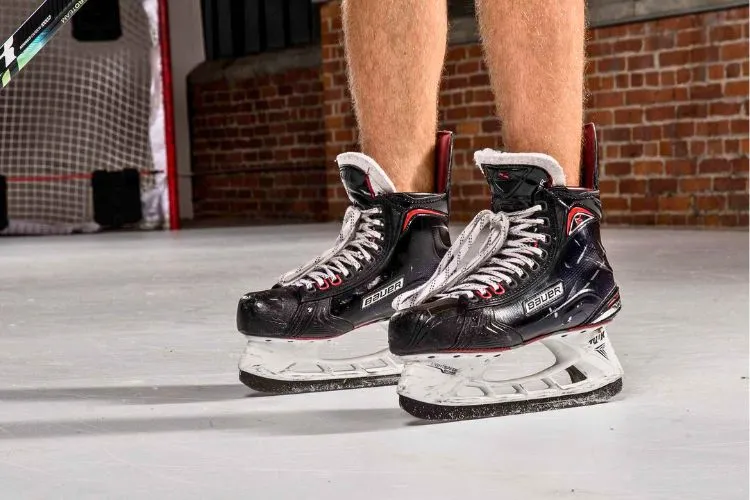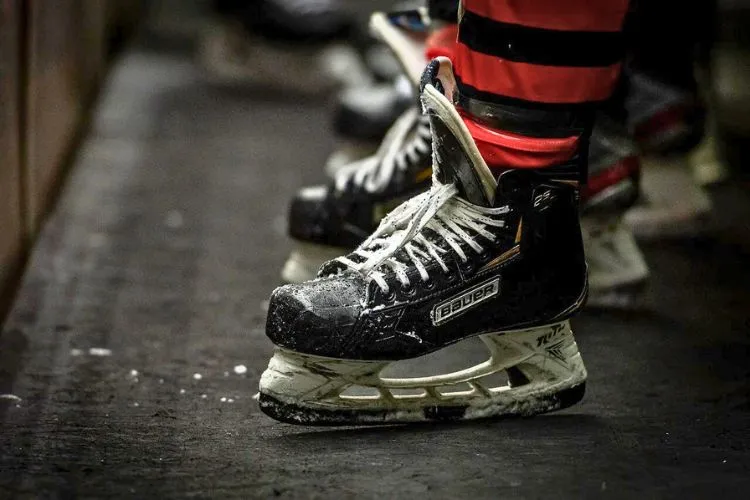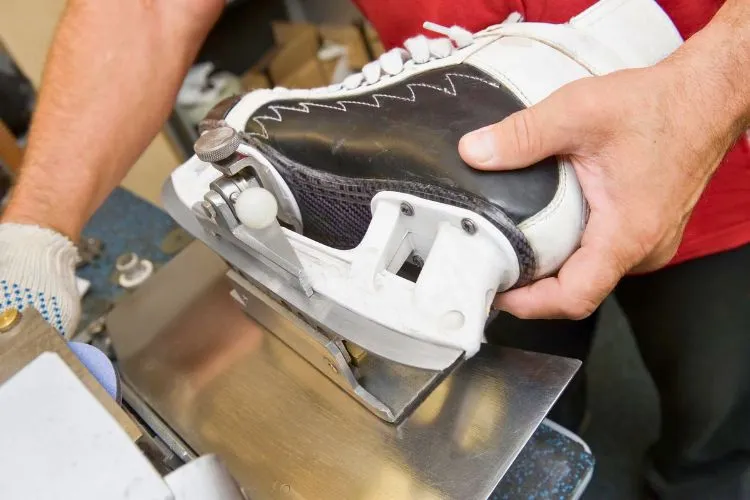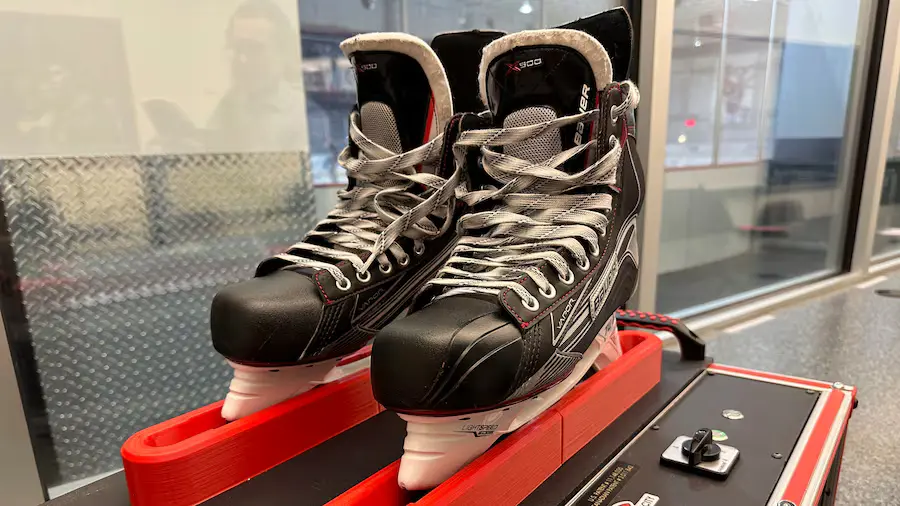Choosing the right hockey skate hollow is crucial for players seeking to optimize their performance on the ice. This choice affects not just the glide and speed but also the grip and turning ability.
Understanding how to pick the right hockey skate hollow and how it influences your game plays a significant role in your overall hockey experience.

Understanding Skate Hollow
Skate hollow refers to the curve cut into the blade’s bottom, creating two edges. This hollow affects how the skates perform. The process involves removing a small amount of metal to create a concave groove.
Skate hollows range from shallow (e.g., 5/8″) to deep (e.g., 3/8″). The depth you choose should match your playing style, weight, and the ice conditions.
Factors Influencing Hollow Choice

Ice Temperature and Conditions
Ice hardness is a key factor when selecting a skate hollow. Softer ice, often found in warmer rinks, may require a shallower hollow.
This prevents skates from digging too deeply into the ice. In contrast, harder ice, typical in colder rinks, pairs well with a deeper hollow for better grip.
Weight of the Player
A player’s weight influences the choice of hollow. Heavier players often benefit from a shallower hollow. This lessens the risk of the skates cutting too deeply into the ice. Lighter players might opt for a deeper hollow to ensure enough grip.
Skating Style and Position
Your position and playing style are crucial in selecting a hollow. Defensive players might prefer a deeper hollow for tight turns.
Offensive players, focusing on speed, could opt for a shallower hollow. Experimenting during practice sessions can help find the best fit for your specific style.
Personal Preference and Comfort
Ultimately, comfort and personal preference play a significant role. While starting with a recommended standard, like the 1/2″ hollow, adjusting based on your experience is key. Listening to your body and performance feedback will guide you to the best choice.
How to Pick the Right Hockey Skate Hollow?
Starting Point
Begin with a commonly suggested measurement, such as 1/2″. This middle-ground hollow offers a balance of speed and agility. From there, make adjustments based on your personal experiences and the factors outlined above.
Experimentation Process
The experimentation process is pivotal in finding the right hollow. Keep a record of the hollows tried and note any changes in your skating performance. Adjust the hollow in small increments to identify what works best for you.
Consulting with Professionals
Experienced skate sharpeners and coaches can offer valuable insights. They might suggest adjustments based on your style, weight, and usual ice conditions. Their expertise can save time and effort in finding the optimal hollow.
Maintaining Your Skate Hollow

Regular Sharpening
To maintain your chosen hollow, regular sharpening is essential. The frequency of sharpening depends on how often you skate. A good rule is to sharpen your skates after every 6-10 hours of ice time.
Checking for Consistency
Ensuring the consistency of your hollow at each sharpening is critical. A reliable skate sharpener is invaluable here. They should consistently deliver the same quality sharpening every time, keeping your skates in top condition.
Signs It’s Time to Adjust Your Hollow
You may need to adjust your hollow if there’s a noticeable change in ice conditions or your skating style evolves. A shift in your weight or a desire for improved performance are also valid reasons for reevaluation.
Be attentive to how your skates feel and perform, as these are clear indicators of when adjustments might be necessary.
The Role of Skate Blade Width
The width of a hockey skate blade plays a crucial role in determining the optimal skate hollow, impacting a player’s stability, agility, and speed on the ice.
Wider blades distribute a player’s weight over a larger surface area, potentially necessitating a shallower hollow to maintain agility and speed, as they inherently provide more stability.

Conversely, narrower blades focus the weight on a smaller surface area, which may benefit from a deeper hollow to enhance grip and maneuverability.
The choice between wider and narrower blades—and consequently, the depth of the hollow—should align with a player’s personal preferences, playing style, and the specific demands of their position on the ice.
Understanding this relationship is key to optimizing performance and achieving a balance between glide efficiency and edge control.
Impact on Injury Prevention
The correct skate hollow contributes significantly to injury prevention in hockey. By providing the appropriate level of grip and stability, players are less likely to experience slips and falls that can lead to acute injuries such as sprains, strains, and fractures.
A hollow that matches a player’s weight and skating style helps maintain control during quick directional changes and sudden stops, reducing the risk of overextension or awkward movements that may cause muscle or joint injuries.
Moreover, consistent edges afforded by the right hollow choice enable better balance, minimizing the chances of falls that could lead to concussions or other impact-related injuries. Thus, choosing the correct skate hollow is an essential aspect of a player’s safety on the ice.
You may also read: How to Tape a Hockey Stick? The Best Guide
Frequently Asked Questions (FAQs)
What is the most popular hockey skate hollow?
The 1/2″ hollow is a popular starting point for many players, providing a balance between grip and glide.
How often should I re-evaluate my hollow choice?
It’s wise to reassess your hollow choice if your skating style, weight, or the ice conditions you play on change.
Can the wrong hollow affect my skating speed and agility?
Yes, a hollow that’s not suited to your needs can hinder your speed and agility on the ice.
Is it easy to switch to a different hollow after getting used to one?
While adjusting might feel different at first, many players can adapt to a new hollow with some practice.
How can I tell if my skates are sharpened unevenly?
Uneven sharpening may cause your skates to veer off to one side. Regularly inspect your blades and feel for any inconsistencies.
Conclusion
Finding the right hockey skate hollow is a personalized journey that significantly impacts your performance on the ice. Considering factors like ice conditions, your weight, playing style, and personal preference will guide you toward the best choice.
Regular maintenance, along with a willingness to adjust and consult with professionals, will ensure your skates are always in prime condition.
Remember, the ideal skate hollow is the one that feels right for you, enhancing your performance and enjoyment of the game.

Matthew James is a passionate skater who wanted to create a platform to share his love for skating with others. With a vision to create a vibrant community of skaters, he aims to provide a space where skaters of all levels can connect, learn, and grow together.
